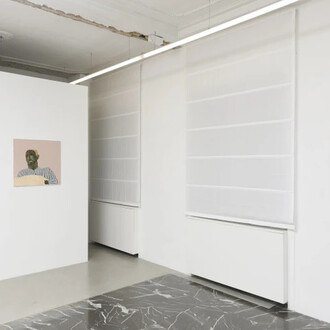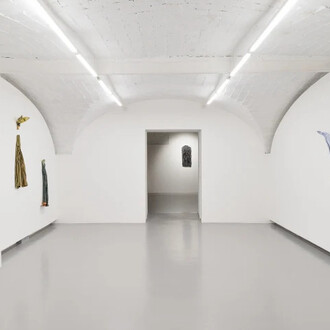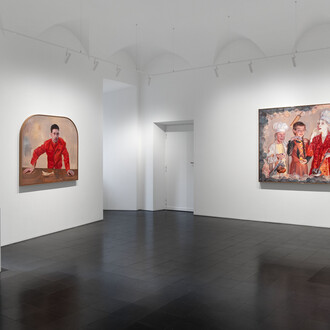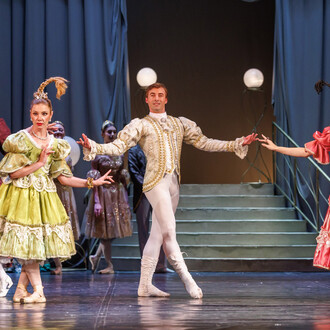The second artist to feature in Monitor’s exhibition calendar is Elisa Montessori (Genoa, 1931), who will debut at the gallery with a solo show accompanied by a critical text by Ilaria Gianni. The show aims to present a broad panorama of Montessori’s artistic research, from her earliest works in the 1970s to some of her most significant pieces from the 1980s (such as the famous La terra dei Masai presented at the 1982 Venice Biennale), up to her most recent production – fresh and strongly contemporary. With her sophisticated trait and composition, Montessori explores the influences of two spheres – the cultural fecundity of the West and the cryptic symbolism of the East. Her personal use of symbols thus brings to the surface the Avant-Garde movements whilst echoing those Eastern disciplines in which a single gesture is able to convey the totality of physical and mental experience. In accordance with her statement that “in my work I strive to subtract”, over the course of her life Montessori has continued to produce works that revolve around the concept of accumulation and subtraction. An artist of many visions, Montessori’s works communicate above all her examination of the deep relation that binds woman to nature intended as a moment of transformation, of metamorphosis.
Mythological tales and parallels with literary texts derive from a privileged channel that the artist has with literature and poetry, so that Montessori’s works accompany the viewer along a harmonious journey of the mind – a never finished promenade through the landscape of the world’s memory and of emotions.
There are times when ancient knowledge buried in the depths of our mind resurfaces, but it has to be necessarily reawakened by the right voices. Elisa Montessori’s one brought back Pliny the Elder, according to whom painting originated when a woman traced the outline of her beloved around the shadow cast by his face – thus leaving its very first mark in the form of a sign that encloses both absence and presence. She also reminded me of Lavoisier’s theory that “nothing is created, nothing is destroyed, everything is transformed”, and of I Ching, the Tao ontology by Lao-Tzu and Chuang-Tzu. Shadow, transformation and emptiness all belong to the lexicon of this artist’s quick-paced work that bridges two worlds and two cultures, generating the sign and the drawing that ensues from it.
On entering Montessori’s studio in Via della Lungara where closets, drawers and shelves overflow with works, the coherence of this artist’s long, dense, multifaceted career is striking. Even with the inevitable interruptions that life has strewn across her path, her development has preserved a remarkable continuity. Since the 1950s Elisa Montessori began resorting to a range of different expressive forms and styles, in a minimal register somewhere between pure abstraction and figurative evocation, without ever falling into the wake of a particular trend, movement or fashion. Hers is the story of the generation of a personal language, an independent, seductive, strong and fertile one. It is also a personal drive towards female emancipation based on creative and political freedom, one that has never accepted gender differentiation when defining a particular repertoire or style, preferring to recognise it as a different way of observing, interacting and interpreting a given vision.
Elisa Montessori’s artistic expression in fact begins from the action of watching and relating to the world as body and gaze, inspired by the compulsivity, freedom, even violence, of the primordial hand gesture that reproduces not what it sees but what it knows. It is a hand that knows more than the eye, endowed with a memory that records experience, not reality. Just like the gaze, the sign is an ever-changing incision and Elisa Montessori’s is a cumulative and subtractive mark that advances, pushing the boundaries of the horizon further and beyond. She captures the interior outlines of things and their interrelations, hence the importance of her shapes silhouetted against a background that represents the unknown, throwing open the door to metamorphosis.
Nature is the source, structure and imprimatur of all of Elisa Montessori’s work, a nature made of vital breaths that animate the universe, understood in its state of incessant becoming, in its constant germination, which is translated into an automatic movement. This culminates in the transformation of landscape, obvious at times, at others barely hinted at, that plays with the line and with the many ways in which it can be broken, devoting itself to spontaneous and imperceptible variations. Elisa Montessori is attracted to imperfection, to coincidence, to irregularity, to surprises and risks. Each of her works hides the unpredictable, encloses a secret.
Nothing is created, nothing is destroyed, everything is transformed. An example of this are Montessori’s Tropismi (1975), first exhibited in Parma and then at the Studio Lia Rumma in Naples in 1977 – three large-scale works measuring 149×148 cm each, made up of many cardboard squares arranged slightly distanced over a backdrop made of gauze. The abstract, reticular ink drawings give way to a series of aero-photogrammetries that compose a bind of images, a natural terrain morphology seen from above. In her Tropismi – a term derived from botany, psychology and music – Montessori develops a lenticular visual perception, a combination of the landscape-logogram (with the typical illusionary and rarefied features of Oriental drawings) and a mechanically documented scene. The aerial space confers on the viewer the faculty of moving within a landscape in which no single focal point exists, where the perspective is in constant evolution in relation to the standpoint. These works document a path between mental vision and vista, between the impalpable and the existent.
Although strongly calligraphic, 14142 x 14142 = 2 square meters of art (1976) is steeped in the artistic legacy of landscape painters such as Gaspard Dughet or Hercules Pieterszoon Seghers. In this work an insistently active sign gradually builds up the space occupied by plant life. A thicket – transparent in places, threateningly dense in others – is rendered in the combination of ink on cardboard and a collage of photographs, generating interdependence between empty and full planes. Among the cornerstones of Tao ontology, the void is considered a sign in its own right – breath, rhythm, action in itself. This work appears to underline the interdependence between presence and absence, an echo of Pliny the Elder’s theory on the birth of painting.
A clear dualism which is evident in the well-known work La terra dei Masai, first shown at the 1982 edition of the Venice Biennale. A distant land where warm ochre sand, clouds and the reflection of the Sun outline the horizon, constructed in a symphony of light compositional touches that stand out against a background of pure air – a transparent expression of void, of absence, of the unknown – evoke a landscape that is both realistic and dream-like. Lightness, transparency and the void are also strong elements of Paesaggi trasparenti (1974), in which thin little plastic sheets are crunched up and left to fall into a two-dimensional sculpture pieces. The same idea was used by Montessori for Kew Gardens (2015), in which she drew on large cellophane sheets that were then arranged in a greenhouse-like structure. Ambiguous, unpredictable and in transformation, each thing is another… Besides nature and myth, it is the very process of observing, experimenting and constructing a work that is subjected to metamorphosis.
Elisa Montessori has discreetly walked her own path through the course of Italian art history with admirable integrity and coherence. Each of her works is a multifaceted, personal and relational itinerary that begins with a hint of a gesture which is able to unleash a series of events and thoughts. Her poetic is a relentless excavation, her hands and eyes brimming with physical and mental experiences in search of a connection between mankind and the world, highlighting the consciousness that art is sacred regardless of religion, occupying a frontier zone that opens a “Door into the Dark” (Seamus Heaney). Elisa Montessori is an artist who lives in the world around her, observing it, carving at its surface, translating it into a spectrum of signs that tell us there is never just one interpretation of what lies before us. And that a picture always poses a question, that it is open to the gaze of other, that seeing one thing always means finding another.
Text by Ilaria Gianni
















